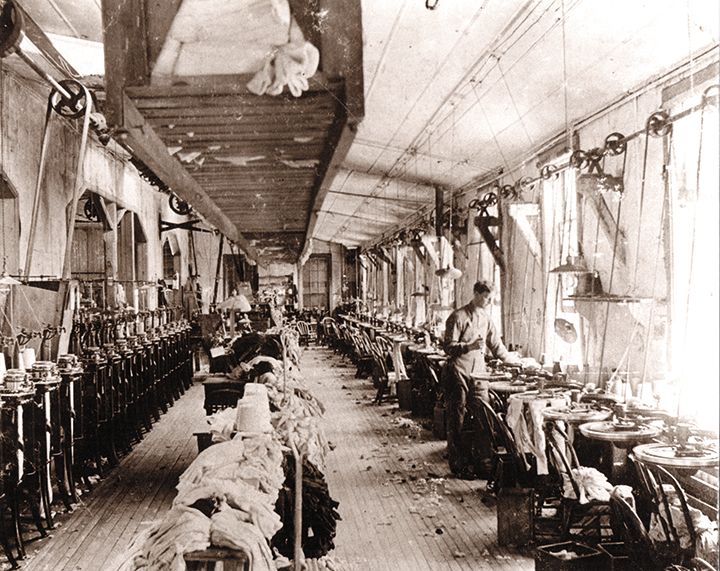Steam Powered Technology
During the early nineteenth century, framesmiths began to make discoveries that paved the way for steam power to be applied to knitting technology.

Cooper, Wells and Co. factory included steam powered knitting machines.
William Lee's frame required a sequence of horizontal and vertical moves to be made by the framework knitter in order to produce knitted goods. The automation of these movements was difficult, particularly when steam engines provided only rotary motion. However, Brunel, a French engineer and father of Isambard Kingdom Brunel, built a machine in 1816 that arranged the needles in a circular form rather than a flat bed. The machine produced a tube of fabric suitable for cut-ups, but it could not create fully-fashioned work. Against the background of resistance to cut-ups, the technology was slow to be introduced in Britain.
Applying power
Warners of Loughborough made the first attempt to apply steam power to a frame in 1829. Success was limited and problems continued to be experienced in controlling the shape of garments. Luke Barton, a hosier from Arnold, patented a device to overcome this problem in 1838. Barton continued to work on his design as an employee of Hine & Mundella in Nottingham. In 1854 this resulted in a machine capable of producing several fashioned stockings at once.
William Cotton of Loughborough secured a patent in 1864 for his rotary-driven machine. This steam-powered machine used a flat bed to produce fully-fashioned garments. The capacity of the machine continued to grow and models were built with sufficient beds to produce in excess of twelve garments at once. Initially Cotton's machines were supplied exclusively to Hine & Mundella. After 1878 Cotton supplied his machinery to the open market and it remained a key machine in the industry for the next hundred years.
Circular machines
On the continent, away from resistance to the cut-up, circular knitting technology continued to be investigated. Peter Claussen from Belgium developed Brunel's idea and patented an improved circular machine in 1845. It could produce a substantial tube of knitted fabric for cutting and be powered by hand or steam. A Claussen machine was brought to Nottingham the same year and was not well received by hosiers wary of the potential reaction from workers. Shortly after 1845, an upturn in the economy created an increased demand for knitted goods and a shortage of knitters. This provided hosiers with an opportunity to introduce the circular machine, although a newspaper from the Great Exhibition noted that 'In addition to this large number known to be employed, many others...are worked secretly in various parts of the town and neighbourhood of Nottingham'. Felkin estimated that 1,200 circular machines were in use by 1864. Old-established firms of merchant houses such as I. & R. Morley, however, continued to resist circulars and remained loyal to its fully-fashioned knitters.
Invention of the latch needle
A huge leap forward for the knitting industry was the invention of the latch needle by Matthew Townsend of Leicester, patented in 1849. Since William Lee's invention of the bearded needle in 1589 all machines had used this needle to operate. The bearded needle required a presser bar and a staged process to pass courses of loops over the beard. Townsend, from Leicester, realised that through the use of a shorter hook on the needle and a hinged latch the process could operate without the need for a presser bar. The latch needle was particularly valuable for circular machines, so it was taken up with more enthusiasm in the USA than in Britain, particularly after Townsend migrated to New England.